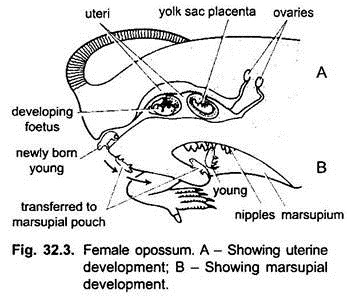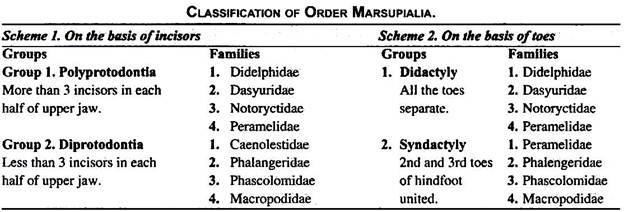Marsupials are mammals basically similar to the Eutheria, but their youngs are born in a rudimentary condition and are generally sheltered during their later development within an integumentary pouch, the marsupium. However, pouch is lacking in the Australian Numbat (marsupial ant- eater, Myrmecobius fasciatus) in which the youngs are dragged along, clinging to the nipples. Marsupium is also lacking in American Chironectes, Marmosa and Monodelphis.
Metatheria are now confined to the Australian region except New Zealand, to South America and to North America. Their classification is based on dentition.
Group 1. Polyprotodontia having more than three incisors in each half of the upper jaw.
ADVERTISEMENTS:
Group 2. Diprotodontia having never more than three incisors in the upper jaw, and one pair in the lower jaw.
Another classification is based on foot-structure (toes), i.e., syndactyly and didactyly.
1. Syndactyly:
Diprotodonts are syndactylous, i.e., second and third digits of the hindfoot are united by a common sheath.
ADVERTISEMENTS:
2. Didactyly:
Polyprotodontia are didactylous, i.e., all toes are separate.
Family 1. Didelphidae:
ADVERTISEMENTS:
These are polyprotodont opossums of North, Central and South America (e.g., Didelphys, Marmosa, Chironectes). They are small, arboreal, generally insectivorous animals with an elongated, naked muzzle, a well-developed nailless opposable hallux and long prehensile tail. An incomplete pouch is present or absent in most living forms. Chironectes (South American opossum) has webbed toes.
Family 2. Dasyuridae:
Terrestrial, carnivorous, pollex rudimentary, foot four-toed, hallux when present, small and clawless and tail non-prehensile. The marsupium is well-developed [e.g., Native cat (Dasyurus), marsupial wolf (Thylacinus), banded ant-eaters (Myrmecobius)].
Family 3. Notoryctidae:
Notoryctes, the Marsupial mole, is a small, burrowing desert animal having short, powerful, furred 5-toed limbs. Third and fourth toes of the forefoot are provided with large, flat, triangular claws. Pinna is absent, eyes vestigial and the fur is silky. Well-developed pouch opens backwards.
Family 4. Peramelidae:
Bandicoots are Australian terrestrial grass and forest dwellers, and usually of burrowing habit. They are of the size of a large rat to that of a rabbit. Muzzle is elongated and pointed. Pinna large and tail is short and also long.
First and fifth digits of the forefeet are vestigial or absent and the remaining three are nearly equal. In hindfoot, the fourth toe is longer and stouter, second and third is small and slender and united by a web of skin, while first is vestigial or absent. Marsupium opens backwards. Examples-Perameles, Thylacis, Macrotis, Chaeropus.
Family 5. Caenolestidae:
ADVERTISEMENTS:
It is represented by Caenolestes, Orolestes and Rhyncholestes. These are South American opossums. These are small rodent-like forms. Toes didactylous, upper dentition polyprotodont and median pair of lower incisors are enlarged.
Family 6. Phalangeridae:
Arboreal phalangers (e.g., Trichosurus, Pseudocheirus) and flying- phalangers (e.g., Petaurus); arboreal, clinging sloth-like koala (Phascolarctos). Phalangers have both fore-and hindfeet prehensile. Second and third toes of hind foot are slender and united by a web, but the hallux is nailless and opposable. Tail is well-developed. Flying phalangers have lateral folds of skin extending from the fore-to the hindlimbs and acting as a parachute during gliding from tree to tree. Koala is sluggish and inoffensive. It eats the leaves of Eucalyptus. It never drinks, but licks up earth. Gestation period is of only 35 days.
Family 7. Phascolomidae:
Wombat (Phascolomys) are large, heavy, thick-bodied vegetarian animals living in burrows and emerging in night. Head short and flat, limbs short, thick with strong claws on all digits except hallux. Tail is very short.
Family 8. Macropodidae:
Kangaroos (Macropus) are herbivorous, adapted for swift terrestrial locomotion. They have small head and neck. The forelimbs are small and five-toed. Hindlimbs are long and powerful. Foot is narrow with four toes, hallux is absent. Second and third toes are small and united by integument.
Middle toe is long and powerful. Tail is very long, usually thick and helps to support the body while at rest. Marsupium is large. Tree-kangaroos (Dendrolagus) have relativery shorter and thicker hindlimbs.

